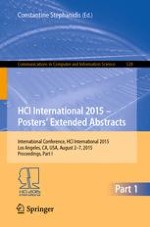This is the first volume of the two-volume set (CCIS 528 and CCIS 529) that contains extended abstracts of the posters presented during the 17th International Conference on Human-Computer Interaction, HCII 2015, held in Heraklion, Crete, Greece in August 2015.
The total of 1462 papers and 246 posters presented at the HCII 2015 conferences was carefully reviewed and selected from 4843 submissions. These papers address the latest research and development efforts and highlight the human aspects of design and use of computing systems. The papers thoroughly cover the entire field of human-computer interaction, addressing major advances in knowledge and effective use of computers in a variety of application areas.
The papers included in this volume are organized in the following topical sections: design and evaluation methods, techniques and tools; cognitive and psychological issues in HCI; virtual, augmented and mixed reality; cross-cultural design; design for aging; children in HCI; product design; gesture, gaze and motion detection, modelling and recognition; reasoning, optimisation and machine learning for HCI; information processing and extraction for HCI; image and video processing for HCI; brain and physiological parameters monitoring; dialogue systems.
